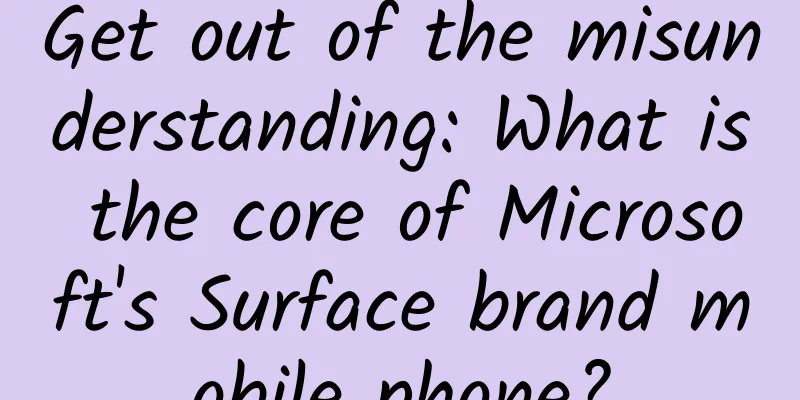Get out of the misunderstanding: What is the core of Microsoft's Surface brand mobile phone?

|
Given the tepid performance of Microsoft's Lumia brand (acquired from the Nokia mobile phone business) in the global smartphone industry, there have been rumors in the industry that Microsoft is developing a new brand and series of smartphones " Surface Phone", and even various detailed function configurations have been leaked on the Internet. With Microsoft's recent registration of the "surfacephone.com" domain name, the credibility of this rumor has increased greatly. So why does Microsoft want to launch a Surface brand phone? If it is launched, what should be the core or competitive point? As we all know, Surface is Microsoft's own tablet brand (different from the tablets that Microsoft licenses Windows to OEM manufacturers) and has gained a certain brand awareness and market share in the tablet market. For this reason, the industry, including Microsoft itself, has consciously or unconsciously fallen into the misunderstanding of Surface. That is, Surface has surpassed its own smartphone brand Lumia in terms of brand influence, actual market share, and revenue. More importantly, Surface has established its position in the tablet market, so with the extension effect of its brand in the tablet market, it can drive Microsoft's growth in the smartphone market. Is this really the case? It is undeniable that when mentioning Surface, the industry immediately thinks of Microsoft's tablet computer and its good sales. However, this so-called good is just a self-congratulation of Microsoft, because in the tablet computer industry to which it belongs, it has not actually had a substantial impact on the tablet computer industry and itself, whether in terms of sales or revenue. According to IDC's statistics on global tablet computer sales in 2015, Microsoft Surface's sales last year did not even enter the top 5, let alone challenge Apple, the originator of the tablet computer industry. That is to say, its annual sales will not exceed 6.5 million units (because the sales of Huawei tablet computers ranked 5th are 6.5 million units), and it is at best the second camp of tablet computers. In view of the overall downward trend of the tablet computer market, the future prospects of Surface tablet computers are not optimistic. What makes us feel that Microsoft Surface tablets lack brand influence and competitiveness in the industry is that in the last quarter, Microsoft's sales of all Surface tablets were not as good as the sales of the iPad Pro tablet, even though Apple's iPad Pro was criticized by the industry. As for revenue, even when Microsoft Surface's revenue increased by 29% year-on-year to $1.35 billion, it was still not as good as the $1.4 billion revenue of the iPad Pro tablet, which was only about 1/5 of Apple's iPad tablet revenue of $7.1 billion in the same quarter. As for Microsoft's own business, the revenue of the Surface series of tablets only accounted for about 6% of Microsoft's overall revenue of $23.796 billion in the quarter. If it is negligible, it is a bit exaggerated, but at least it did not have a substantial impact on Microsoft's performance. The reason why we made the above analysis is to show that if Microsoft releases a Surface-branded phone in the future, it would be a big mistake to simply or mistakenly believe that it can replace Lumia in the smartphone market by relying on the brand extension effect of Surface's success in the tablet market. Because as we analyzed earlier, in the tablet industry and market, Surface's actual market performance is not eye-catching. So the question is, is it necessary for Microsoft to release a Surface-branded smartphone? Here we might as well briefly review the development of the Surface brand. In short, at that time, OEM manufacturers in the tablet market were not "interested" in tablets equipped with Windows systems. So Microsoft released its own tablet computer more out of helplessness, and even so, Surface took a detour. That is, in order to comply with or cater to the trend of ARM being the mainstream in the mobile market (smartphones and tablets), ARM+Windows and x86+Windows (Wintel) were adopted. The former is Surface RT, and the latter is the current Surface Pro, but both belong to the Surface brand. Later market development proved that, not to mention compared with Apple's iPad, compared with the tablet computers in the Android camp of ARM+Android, Microsoft's ARM+Windows Surface RT experience is extremely poor. This is also the main reason why Microsoft finally gave up the development of Surface RT, and all its Surface-branded tablet computers turned to the Wintel combination of Surface Pro series and gained relative market recognition and success. The reason why we call it relative recognition and success is only for Microsoft itself, that is, in the competition between ARM+Windows and Wintel, the market and users recognize x86+Windows more, and this is the core of the Surface brand or the essence behind it. This naturally leads to the core of Microsoft's Surface brand smartphone, which is the Wintel combination, or more precisely, the Wintel ecosystem. After all, the ARM+Windows ecosystem used by Microsoft's current smartphone Lumia has been proven to have no competitive ability in the smartphone market. Therefore, whether it is from the perspective of ecological complementarity (Lumia still uses ARM+Windows, Surface uses Wintel) or the last-ditch strategy (eliminating Lumia with the ARM+Windows ecosystem and only using the new Wintel ecosystem for Surface), Surface can only use a single Wintel ecosystem to have the meaning and value of launching. On the contrary, if Microsoft's Surface brand mobile phone still uses the ARM+Windows ecosystem combination, it will not only be no different from the current Lumia, but may also cause a fight between the two parties. More importantly, the relative brand influence, market share and growth of the Surface brand in the tablet market have proved that the Winte combination is its real core value, not the brand itself. As a winner of Toutiao's Qingyun Plan and Baijiahao's Bai+ Plan, the 2019 Baidu Digital Author of the Year, the Baijiahao's Most Popular Author in the Technology Field, the 2019 Sogou Technology and Culture Author, and the 2021 Baijiahao Quarterly Influential Creator, he has won many awards, including the 2013 Sohu Best Industry Media Person, the 2015 China New Media Entrepreneurship Competition Beijing Third Place, the 2015 Guangmang Experience Award, the 2015 China New Media Entrepreneurship Competition Finals Third Place, and the 2018 Baidu Dynamic Annual Powerful Celebrity. |
<<: Snapdragon 820 version of Samsung S7 latest running score exposed: a new high
>>: Android Wear update: support for new gestures and listening to voice messages
Recommend
Intel i3 vs i5: Which processor is right for you?
In the current computer processor market dominate...
The “screenwriter’s mindset” for creating hit short videos
In 2020, the number of creators on the short vide...
Top 10 marketing keywords in 2018!
Usually at the end of the year, there will be var...
Toutiao’s addictive data mining
Due to some irresistible forces, Toutiao 's p...
Can anyone help me see if this bowl is red bean soup or mung bean soup?
The answer is: mung bean soup! Mung bean soup, kn...
OS X is not secure? But it is better than Windows.
[[152379]] Apple's OS X desktop operating sys...
Yutong Bus and Juefei Technology jointly launched autonomous driving technology for the first time in domestic passenger buses
Recently, Juefei Technology cooperated with Yuton...
Electric Technology Car News: How can the Lifan X80, which is very similar to the Highlander in appearance and interior, make a comeback?
This year, the automobile market has welcomed man...
The tableware you use every day, using it incorrectly is equivalent to chronic "poisoning"! Be careful of these 7 types of materials →
Tableware is something we come into contact with ...
OpenSignal: 4G penetration in Singapore is close to 90%
OpenSignal analyzed the penetration of 4G in Sing...
Hangzhou Research Institute of Hard Science | Build a 3D map with just a “backpack”!
Radar, communication, navigation, antenna, optoel...
Chuzhou Mini Program Production Company, how much does it cost to produce a fast food mini program?
The launch of mini programs has brought convenien...
How to upload APP software to the Android App Store
Currently in the domestic software market, the va...
Gree mobile phone experience: I am not a mobile phone, but a complete air conditioning ecosystem
In the era of the booming smartphone market, many...
If the concert encounters artificial rainfall, can it be rescheduled? | Expo Daily
If the concert encounters artificial rainfall , c...









